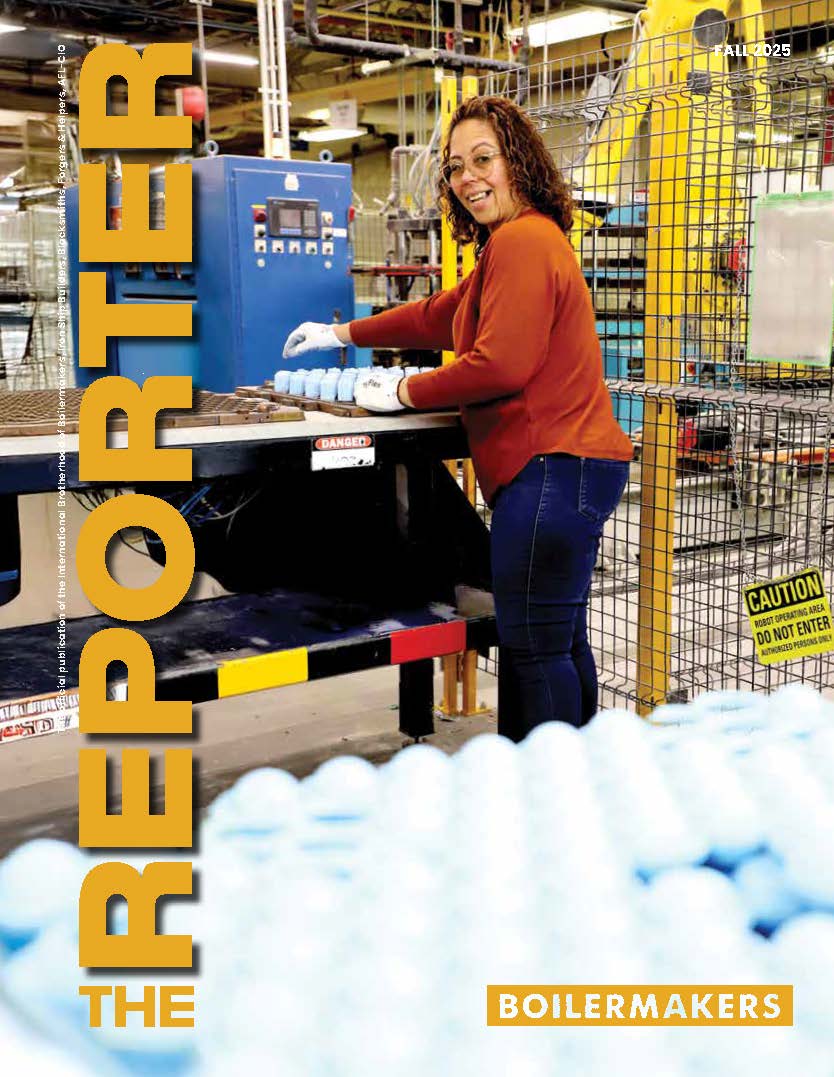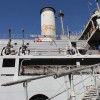Contestants try on commemorative jackets during a reception. Kneeling, l. to r., Alexandre LaPalme-Lajeunesse, L-271; Joe Beauchamp, L-128; and Sean Walsh, L-203. Standing, l. to r., Ross Thompson, L-359; Brian Loos, L-359; Justin Brkic, L-73; Nathalie Delisle, L-271; Cory Malakoff, L-555; Roger McGuire, L-555; Paul Salisbury, L-128; James Mason, L-203; Dixon Lewis, L-73; Clayton Chiurka, L-146; and Neil Bennett, L-146.
View Photo Gallery (10 photos)
L-146 pair captures first team event, first female Boilermaker competes
TWO MEMBERS OF Local 146 (Edmonton, Alberta) shared the first-ever team honors in the Canadian Boilermaker Apprenticeship Competition held at the New Brunswick Community College in Moncton June 24-28. Neil Bennett and Clayton Chiurka placed first in a field of seven teams from across the nation. The duo also won individual honors as top Boilermaker graduate apprentices — Bennett for 2011, Chiurka for 2012.
The contest also marked the first time a female Boilermaker, L-271's Nathalie Delisle, has reached national-level apprentice competition in Canada or the United States.
It was the 18th competition and the first to be held under the new biennial format, which pairs each lodge’s top graduate apprentices from consecutive years. Local 73 (Halifax, Nova Scotia) hosted the 2012 event. The next competition will be held in 2014 in Vancouver, British Columbia, for the top apprentices of 2013 and 2014.
“I couldn’t be happier with the way our new format worked,” said Grant Jacobs, Canadian Director of National Training and Apprenticeship. “We set a new footprint for future competitions with the new team structure.”
Jacobs announced the winners during a banquet June 28 at the Delta Beauséjour Hotel in Moncton. The winner of the 2012 Industry Achievement Award, Bruce Ashton, also received recognition, with International Vice President for Eastern Canada Ed Power presenting a trophy for Ashton’s contributions to apprenticeship and the construction industry. Ashton retired in 2004 after serving as national coordinator for the Boilermaker National Training Trust Fund in Canada. He is a co-author of the trade reference, “IPT’s Metal Trades & Welding Handbook,” which has over 250,000 copies in circulation.
Also competing in the event were Justin Brkic and Dixon Lewis, Local 73 (Saint John, New Brunswick); James Mason and Sean Walsh, Local 203 (St. John’s, Newfoundland); Joe Beauchamp and Paul Salisbury, Local 128 (Toronto, Ontario); Nathalie Delisle and Alexandre LaPalme-Lajuenesse, Local 271 (Montreal, Quebec); Brian Loos and Ross Thompson, Local 359 (Vancouver, British Columbia); and Kory Malakoff and Roger McGuire, Local 555 (Winnipeg, Manitoba).
Contestants vie in written and practical tests
THE COMPETITION GOT underway June 24 with a written exam lasting up to six hours. The test covered the common-core, in-school training curriculum as well as questions on the Boilermaker Constitution and bylaws.
On June 25, the event shifted to three days of practical tests, with contestants competing in five areas: rigging, welding, layout and fitting, tube rolling and waterwall repair, and tube assembly.
In the rigging exercise, contestants worked in teams to lift a 10,500-lb. heat exchanger and move it through a maze of concrete barriers. While one team member directed the lift using hand signals to a crane operator, the other contestant controlled the movement of the load manually. The signalman was not allowed to touch the load at any time and was required to keep it within the barriers and no more than 18 inches off the ground. The exercise required the team to rotate the heat exchanger 180 degrees, with team members switching roles and reversing course to the point of origin.
Rigging judge Jim Beauchamp, an instructor at Red River College in Manitoba, said communication skills were essential between team members to avoid over-correcting by the load handler.
In the welding test, contestants joined 3/4-inch steel plate coupons using both horizontal and flat welds. The candidates also marked up and cut out a lifting lug from 1-inch plate without using the straight edge of the plate as one of the lug’s three sides. The exercise required contestants to cut a 2-inch hole into the lug and a 45-degree bevel on one side — without finishing the edges with a grinder.
“Everything was cut by hand,” said welding judge Darrel Bray, business rep for Locals 555/128 in Thunder Bay. “We wanted to see how well they could cut and how much slag was left behind.”
Bray said the welding part of the exercise simulated the same type of joint that might be used to connect a tank floor and tank shell.
The layout and fitting team event required contestants to cut out and assemble a hopper with flanged openings. The exercise involved measuring and cutting components from a single sheet of 4-ft. x 8-ft. steel plate and welding the pieces together to specification.
“The whole idea is to minimize the amount of wasted material by properly nesting the required pieces,” said judge Ken Bachand, an instructor at the Northern Alberta Institute of Technology in Edmonton. “They had to do some math and put all those things together that they learned throughout their apprenticeship. I think the biggest challenge was to set up the correct formulas so they got the right measurements for their slant heights.”
In the waterwall and tube rolling event, contestants performed tasks related to boiler construction and repair.
Working as a team, they cut and removed a damaged tube section and replaced it with a short tube (commonly called a “pup” or “Dutchman”).
“The exercise mimics real-life boiler work, with one person on the fire side of the waterwall and one person on the other side,” said judge Marcel Losier, a Local 73 member and construction supervisor with B&W. “It is something we do in almost every emergency where there’s a blow-out on a tube.”
The tube rolling portion of the exercise required contestants, competing individually, to expand a tube into a mock tube sheet using the appropriate rolling equipment.
“They have to use the proper formula to expand the tube to the percentage that we give them, with the specified flaring,” Losier said.
The final event challenged the communication and collaboration skills of the contestants. The seven teams assembled in the college gymnasium in a heart-pounding race to assemble a plastic tubular structure to specifications. Local 146’s Bennett and Chiurka scored the best time, just seconds ahead of several other teams.
Other judges scoring the individual exercises were Ed Hoffmann, instructor, Humber College; Evan Renaerts, construction manager, CIMS British Columbia; Ray Reed, instructor, British Columbia Institute of Technology; Gerry Zurburg, shop superintendant, Cessco, Alberta; Al Bennett, training coordinator, Local 359; Gabriel Beaulieu, superintendant, Descimco, Quebec; Allan Belter, training coordinator, Local 146; Joe Flynn, training coordinator, Local 203; and alternates Marty Albright, director of Labour Relations EH&S, Alstom Canada; and Dave Ralph, training coordinator, Local 146.
Test coordinators included Marc Leblanc, an instructor with New Brunswick Community College, and Jonathan White, assistant national training coordinator for Canada.
















